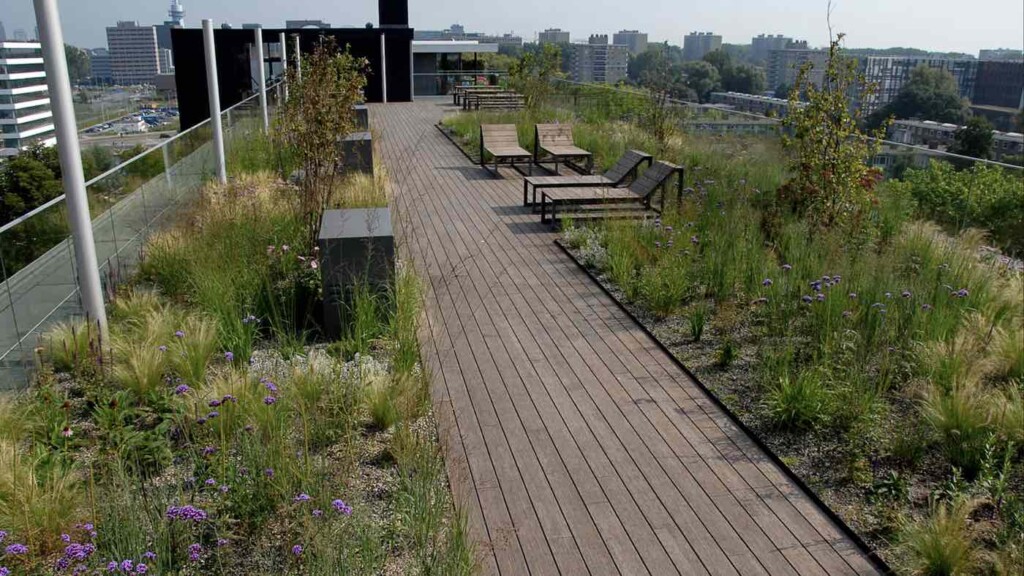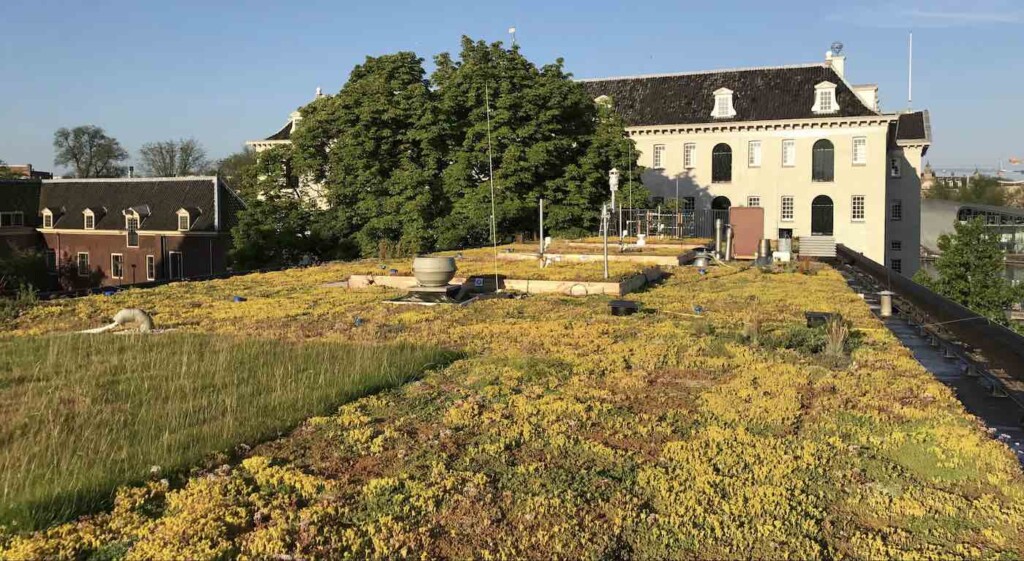
Amsterdam’s roofs have just been converted into a giant sponge that will make the city more climate resilient.
The Dutch have always been famous for their ability to control water, born out of the necessity of their homeland, much of which is below sea level.
Now, their expert water management skills are transforming the city skyline in the capital city of Amsterdam from one of terracotta tile, concrete, and shingles into green grass and brown earth.
It’s part of a new climate-resiliency trend in architecture and civic planning known as the ‘sponge city concept,’ in which a garden of water-loving plants, mosses, and soil absorbs excess rainwater before feeding it into the building for use in flushing toilets or watering plants on the ground.
If heavy rains are predicted, a smart valve system empties the stored rainwater into the municipal storm drains and sewers in advance of the weather, allowing the roof to soak up water and reduce flooding in the city.
In this way, the rooftops of buildings can be wrung out and filled up just like a sponge.
In Amsterdam, 45,000 square meters, or 11 acres of flat metropolitan rooftops have already been fitted with these systems, and the contracting firms behind the technology say they make sense in dry climates like Spain just as much as in wet climates like Amsterdam.

Rains, some scientists believe, will become heavier and more erratic in their delivery as the climate changes. Flooding costs billions in damages in countries like the UK, Netherlands, and Italy which just last year experienced terrible flooding in the plains of Emiglia Romagna.
OTHER ROOFTOP REVOLUTIONS: European Cities Are Turning Rooftops Into Community and Sustainability Hubs: âA revolution in urban planningâ
A 4-year project of different firms and organizations called Resilio, the resilient network for smart climate adaptive rooftops, rolled out thousands of square meters of sponge city technology into new buildings. As with many climate technologies, the costs are high upfront but tend to result in savings from several expenditures like water utilities and water damage, over a long-enough time horizon.
Companies like Waternet, MetroPolder Company, Rooftop Revolution, HvA, VU, Stadgenoot, de Alliantie, and De Key all participated in the transformative effort that has left many buildings capped with green bonnets of ferns, mosses, small shrubs, and sedum, a genus that is particularly suited to turf rooftops.
All together, Amsterdam’s sponge capacity is over 120,000 gallons.
âWe think the concept is applicable to many urban areas around the world,â Kasper Spaan from Waternet, Amsterdamâs public water management organization, told Wired Magazine. âIn the south of EuropeâItaly and Spainâwhere there are really drought-stressed areas, thereâs new attention for rainwater catchment.â
Indeed the sponge city concept comes into a different shade when installed in drought-prone regions. Waters absorbed by rooftops during heavy rains can be used for municipal purposes to reduce pressure on underground aquifers or rivers, or be sweated out under the Sun’s rays which cools the interior of the building naturally.
MORE STORIES LIKE THIS: India Approves Massive $9 Bil. Rooftop Solar Plan with Panels for 10 Million Homes
Additionally, if solar panels were added on top of the rooftop garden, the evaporation would keep the panels cooler, which has been shown in other projects to improve their energy generation.
âOur philosophy in the end is not that on every roof, everything is possible,â says Spaan, âbut that on every roof, something is possible.â
Matt Simon, reporting on the Resilio project for Wired, said succinctly that perhaps science fiction authors have missed the mark when it came to envisioning the city of the future, and that rather than being a glittering metropolis of glass, metal, and marble as smooth as a pannacotta, it will look an awful lot more like an enormous sculpture garden.
SHARE This Innovative Concept Of Sponge Cities With Your Friends…Â

